Proteomics Reveals Global Regulation of Protein SUMOylation by ATM and ATR Kinases during Replication Stress, aiming to analyze the mechanism of signal transduction, interaction and association of sumo and phosphorylation in the face of DNA replication stress by mass spectrometry.
IF 8.282

Subject background
Eukaryotic DNA replication is a time-consuming and very challenging process. The normal development of DNA replication is the basis for maintaining normal cellular activities, so precise protection mechanisms are needed to cope with fluctuations in the internal and external environment. Once the protection mechanism is disordered, the genome is disordered. Even cancer occurs. Numerous reports have shown that precise and accurate post-translational modification escorts DNA replication through the DNA damage response mechanism DDR (DNA damage response), and the important role of the signal transduction process relying on phosphorylation modification is well known. Recently, it has also been found that SUMO modification also plays a very important role in this process. However, whether the response of the two levels of modification at the time of DNA replication damage has an interaction, and the correlation is still little known . The subject of this article, with such questions, conducts an in-depth study of the two large-scale omics interactions and associations to explore the relationship between the two omics in DNA damage response.
Experimental results
The SUMM-stimulated cells were subjected to SUMO-modification and phosphorylation for protein or peptide enrichment, qualitative and quantitative analysis, and then analyzed by phosphorylation of modified proteins. SUMO modified proteins were consistent in expression and modified protein species. The overlap and the comparison of GO functional similarity found that it was found that some key proteins UIMC1, BRCA1, etc., were also phosphorylated when SUMO was formed during DDR. Further analysis of the two modified proteins was carried out by a large-scale analytic labelfree experiment. It was found that in the DNA damage repair, the interaction of the two modified responses was formed to form an interaction network to cope with external damage. Finally, the key through ATR kinase DDR, RS response, the substrates of the ATM before and after administration of the modified verification analysis, ATR CHK1 activation of DNA damage when found, it is phosphorylated, and ATR-activating factor TOPBP1 common height of sumo . The mechanism of the two modifications is further revealed.
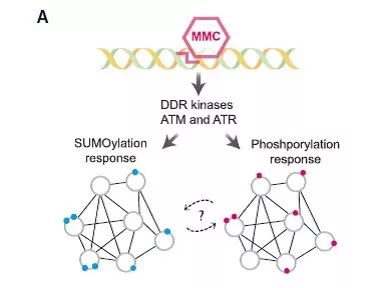
Experimental route
U-2-OS cells stably transformed by flag-SUMO-2 and his10-sumo-2-k0-Q87R were established, and subjected to SILAC (stable isotope labeling) technique for cell culture. After the cells were synchronized with the thymidine blocking method for 24 hours, MMC (Mitomycin) was administered and stimulated to produce a DNA damage state, respectively, to a negative control (untransfected SUMO), SUMO Steady-transfer stimulation and non-administration stimulation of three conditions of cellular protein for IP enrichment, mass spectrometry by high-resolution mass spectrometer Q-Exactive high-frequency (HF), using SUNUM protein to SUMO protein and SUMO position Point for qualitative quantification. Among them, it is worth mentioning that in the SUMO assay, the more traditional exogenously introduced FLAG-SUMO2-Q87RSUMO protein mutant method is used to enrich the SUMO protein, and the molecular weight of QQTGG and pyroQQTGG after digestion Offset for SUMO site identification . A total of 3453 proteins were identified, of which 702 were significantly different SUMOylated proteins. In the stable SUMO-2 cells stimulated by MMC, a total of 187 SUMO proteins were significantly increased by MMC stimulation, and a total of 311 SUMO sites.
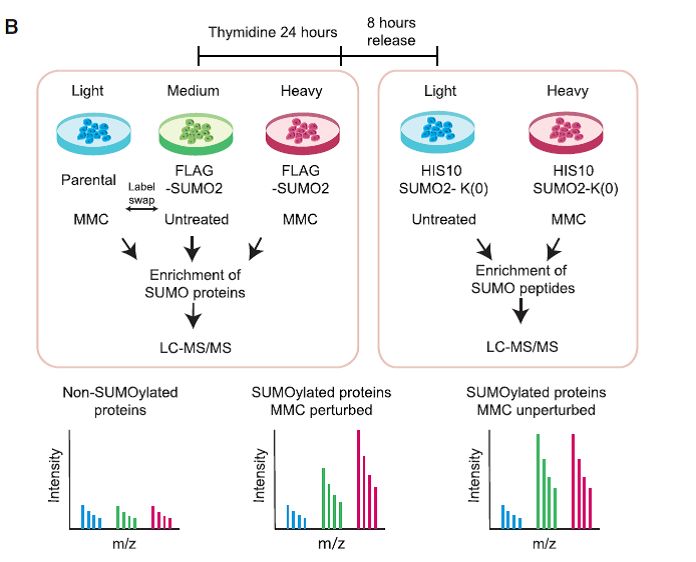
Sumo protein function analysis
Functional annotation and interaction network analysis of SUM MMC-affecting sumo proteins revealed that these proteins are mainly localized in the nucleus and are mainly involved in cell repair.
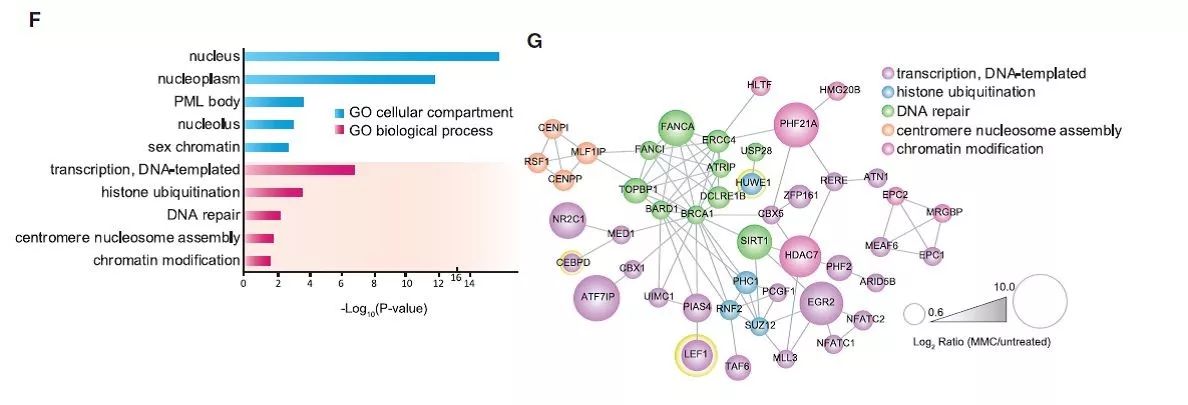
Phosphorylation modification analysis
In the phosphorylation large-scale modification analysis experiment, the experimental design is the same as the SUMOization, and the classical phosphorylation enrichment method-TIO2 is adopted on the technical route, and the identification level of the phosphorylated peptide is improved by the classification method. A total of 20900 phosphorylation sites were identified by this method, of which 650 phosphorylation sites were significantly up-regulated by MMC treatment. Through GO analysis, it was also found that the main localization of cells is related to DNA damage repair, which is strikingly similar to the result of sumo.
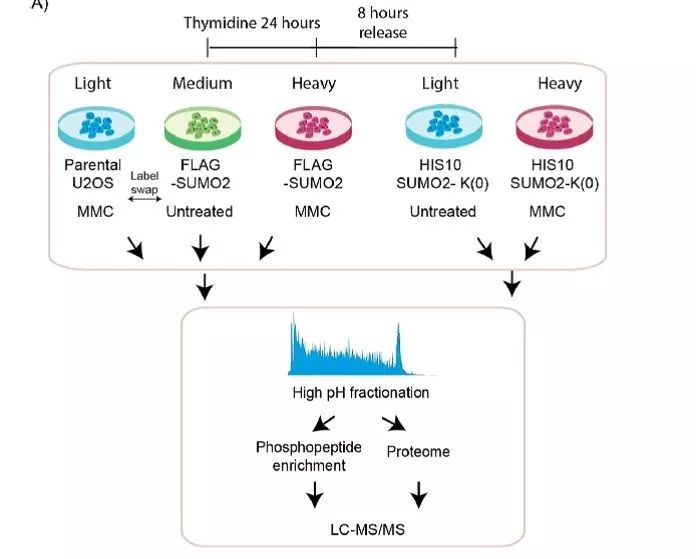
Combined analysis of phosphorylation and sumo
To illustrate the close relationship between phosphorylation and sumo, the quantitative levels of these MMC-affected proteins were compared and it was found that the quantitative expression profiles of the differential proteins found by the two histologies were highly consistent.
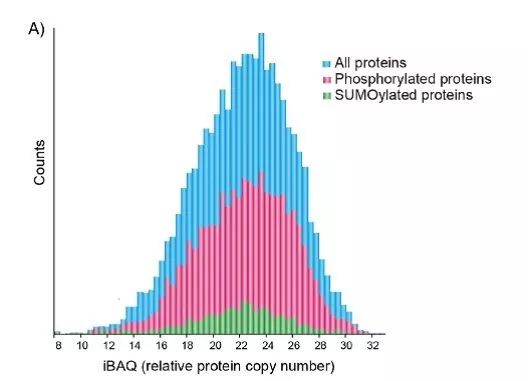
By comparing the overlap of protein species, it was found that 540 proteins were simultaneously ubiquitinated and phosphorylated, 17 of which were up-regulated after MMC stimulation, including the reported DDR-related Key proteins such as UIMC1, BRCA1, etc.
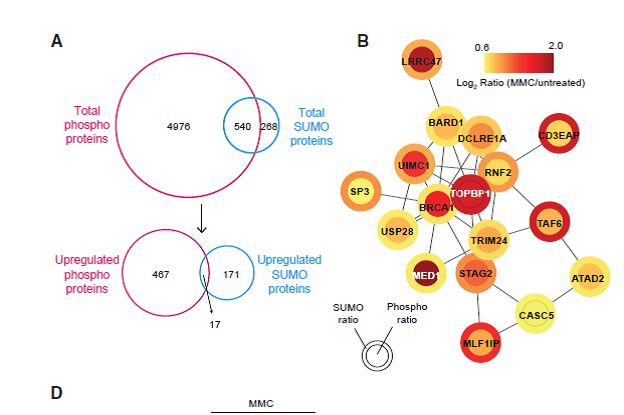
In order to explore the mechanism of action of the two modifications in DDR and RS (replication stress), the key protein kinase ATR, ATM phosphorylation and SUMOylation level changes in this process were further verified by WB. Through the DNA damage stimulation and the SUMOylation and phosphorylation levels of the related kinase substrates before and after treatment with ATR inhibitors, it was confirmed that the activation of key kinases was through the phosphorylation of substrates and SUMO and other signals to form and interact. And a supplementary label-free analysis was carried out to verify the above conclusions.
Xiaobian experience
This paper uses a large number of mass spectrometry techniques to carry out in-depth qualitative and quantitative studies on SUMO and phosphorylation under specific conditions, and conducts correlation analysis to explain in depth the changes of the two levels of modification during DNA damage. Mutual influence is a very typical technique for mass spectrometry. It not only has modified enrichment technology, but also utilizes ordinary labelfree technology, SILAC technology, etc. These are very classic methods in the field of mass spectrometry. Learning and even joint analysis of omics provides a certain idea, which is worth learning and learning!
Dried Sweet Potato,Dehydrated Sweet Potatoes,Dried Sweet Potatoes Flakes, Air Dried Sweet Potatoes, Dried Super Sweet Potatoes
Jiangsu Tiankang Food Co., Ltd. , https://www.tiankangfood.com